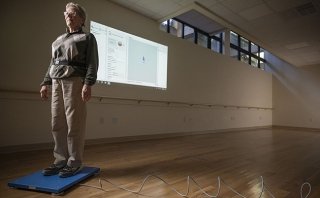Hip Fractures to Nearly Double Worldwide by 2050
Researchers Call for Urgent Action in Hip Fracture Prevention
-

Senior Scientist
An international group of researchers led by the Department of Pharmacology and Pharmacy, LKS Faculty of Medicine, the University of Hong Kong (HKUMed), and including Douglas P. Kiel, M.D., MPH, director of the Musculoskeletal Research Center, Hinda and Arthur Marcus Institute for Aging Research, Hebrew SeniorLife, and professor of medicine, Harvard Medical School, evaluated the secular trends in hip fracture incidence, treatment patterns following a hip fracture, and all-cause mortality in 19 countries and regions from 2005 to 2018. While the age- and sex-standardised hip fracture incidence rates decreased in most regions, the number of hip fractures worldwide are projected to nearly double by 2050 compared to 2018. A significant treatment gap of patients sustaining a hip fracture not receiving therapy to prevent future fractures was also observed in all countries and regions, particularly in men. The study, recently published in Journal of Bone and Mineral Research, highlights an urgent need for better strategies in hip fracture prevention and care.
Background
Hip fracture remains a global public health concern contributing to increased dependency, morbidity, and mortality, and placing a burden on patients, their families, and healthcare systems. In this international study, researchers directly accessed to the data from a large representative cohort involving 19 countries and regions to examine the incidence of hip fractures, treatment following a hip fracture, and all-cause mortality following hip fractures, among patients aged 50 years and older, from 2005 to 2018.
Previous reports on hip fracture incidence have been based on data with heterogeneity in data sources, study periods, and analytical approaches. In contrast, this study applied a standardised protocol and a common data model across all sites to provide comparable data.
Age- and sex-standardised incidence rates of hip fracture were estimated using the 2020 United Nations world population as a standard. The number of hip fractures in 2030, 2040, and 2050 were projected based on the trends in the incidence rates and the World Bank data. Within 12 months following hip fractures, the proportion of patients receiving anti-osteoporosis medication, and the all-cause mortality rates were estimated.
Research findings and significance
A total of 4,115,046 hip fracture cases were identified in the cohort. The reported age- and sex-standardised incidence rates of hip fractures ranged from 95.1 (Brazil) to 315.9 (Denmark) per 100,000 population. Most countries and regions showed a decreasing trend in hip fracture incidence, with the most pronounced declines in Denmark (‐2.8% per year), Singapore (‐2.8%), and Hong Kong (‐2.4%). The largest increases were noted in the Netherlands (+2.1%), and South Korea (+1.2%). Despite the overall decline in hip fracture incidence, the total number of hip fractures is estimated to nearly double from 2018 to 2050.
Within 1 year following a hip fracture, post-fracture treatment remained low throughout the years, ranging from 11.5% in Germany to 50.3% in United Kingdom. One-year all-cause mortality rates ranged from 14.4% (Singapore) to 28.3% (United Kingdom), while mortality trends varied from ‐5.3% to +18.4% per year. Males had lower use of anti-osteoporosis medication than females, higher rates of all-cause mortality, and a larger increase in the projected number of hip fractures by 2050.
The study highlights substantial variations in the global epidemiology of hip fractures and the treatment after hip fracture across countries and regions. A key message from the study is that decline in hip fractures in many countries in recent years is not enough to offset the impact of the aging population. The burden of hip fracture is expected to continue to grow. Given that hip fracture is not only a medical issue, but also a social issue that often requires institutionalisation, government policy and multidisciplinary intervention should be considered to reduce the impact of the hip fracture in the coming 30 years.
About the research team
The research was led by
- Dr. Chor-Wing Sing, Research Assistant Professor Department of Pharmacology and Pharmacy, HKUMed (First author)
- Dr. Ching Lung Cheung, Associate Professor, Department of Pharmacology and Pharmacy, HKUMed (Co-corresponding author)
- Professor Ian Chi Kei Wong, Lo Shiu Kwan Kan Po Ling Professorship in Pharmacy,
Head of Department of Pharmacology and Pharmacy, HKUMed (Co-corresponding author)
Other co-authors include (in alphabetical order)
| Sharon Bartholomew, MHSc | J Simon Bell, PhD | Corina Bennett, MS |
| Kebede Beyene, PhD | Pauline Bosco-Levy, M.D. | Brian D. Bradbury, DSc |
| Amy Hai Yan Chan, PhD | Manju Chandran, M.D. | Cyrus Cooper, FMedSci |
| Maria de Ridder, PhD | Caroline Y. Doyon, MSc | Cécile Droz Perroteau, PhD |
| Ganga Ganesan, MSc | Sirpa Hartikainen, PhD | Jenni Ilomaki, PhD |
| Han Eol Jeong, PhD | Douglas P Kiel, M.D., MPH | Kiyoshi Kubota, PhD |
| Edward Chia-Cheng Lai, PhD | Jeff L. Lange, PhD | E Michael Lewiecki, M.D. |
| Julian Lin, PhD | Tzu-Chieh Lin, PhD | Jiannong Liu, PhD |
| Joe Maskell, MSc | Mirhelen Mendes de Abreu, M.D. | James O’Kelly, PhD |
| Nobuhiro Ooba, PhD | Alma B. Pedersen, PhD | Albert Prats-Uribe, M.D. |
| Daniel Prieto Alhambra, M.D. | Simon Xiwen Qin, PhD | Ju-Young Shin, PhD |
| Henrik T. Sørensen, DMSc | Kelvin Bryan Tan, PhD | Tracy Thomas, MSc |
| Anna-Maija Tolppanen, PhD | Katia M.C. Verhamme, M.D. | Grace Hsin-Min Wang, PhD |
| Sawaeng Watcharathanakij, PhD | Stephen J. Wood, Bpharm |
Douglas P Kiel, M.D., MPH, is professor of medicine, Harvard Medical School; director of the Musculoskeletal Research Center, Marcus Institute for Aging Research, Hebrew SeniorLife; and associate member, Broad Institute of Harvard and MIT.
About Hebrew SeniorLife
Hebrew SeniorLife, an affiliate of Harvard Medical School, is a national senior services leader uniquely dedicated to rethinking, researching, and redefining the possibilities of aging. Hebrew SeniorLife cares for more than 3,000 seniors a day across six campuses throughout Greater Boston. Locations include: Hebrew Rehabilitation Center-Boston and Hebrew Rehabilitation Center-NewBridge in Dedham; NewBridge on the Charles, Dedham; Orchard Cove, Canton; Simon C. Fireman Community, Randolph; Center Communities of Brookline, Brookline; and Jack Satter House, Revere. Founded in 1903, Hebrew SeniorLife also conducts influential research into aging at the Hinda and Arthur Marcus Institute for Aging Research, which has a portfolio of nearly $85 million, making it the largest gerontological research facility in the U.S. in a clinical setting. It also trains more than 1,000 geriatric care providers each year. For more information about Hebrew SeniorLife, visit our website or follow us on our blog, Facebook, Instagram, Twitter, and LinkedIn.


